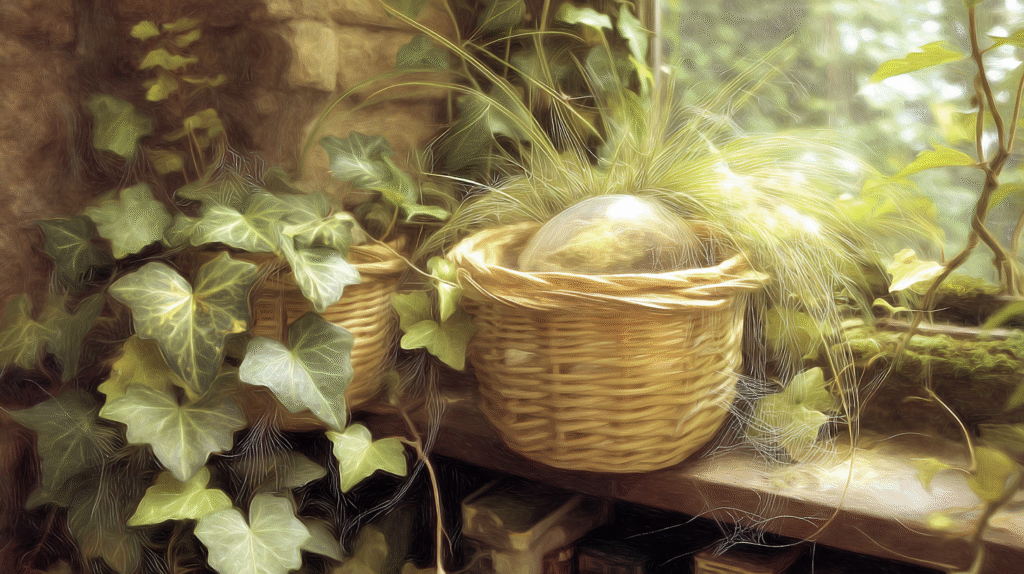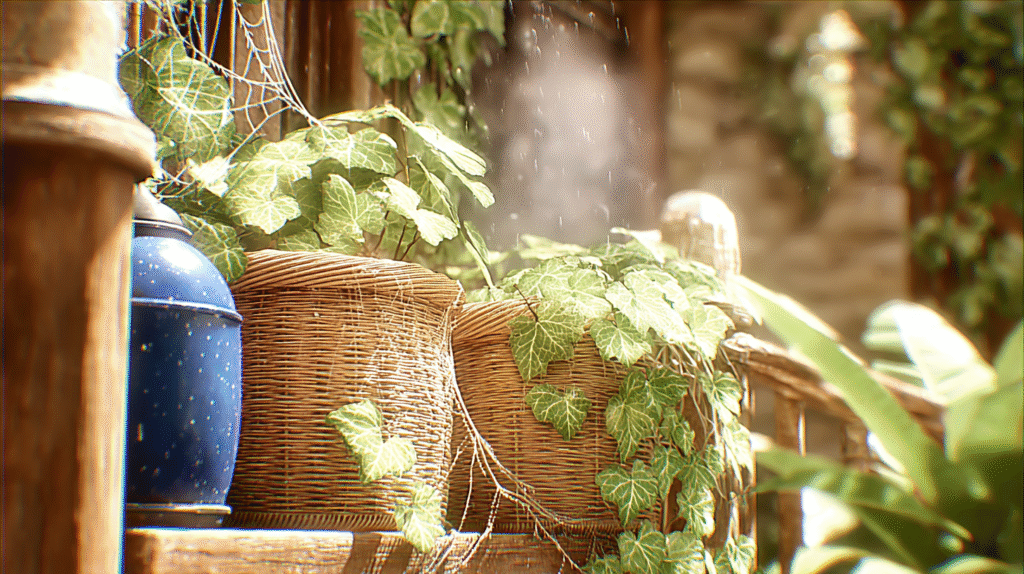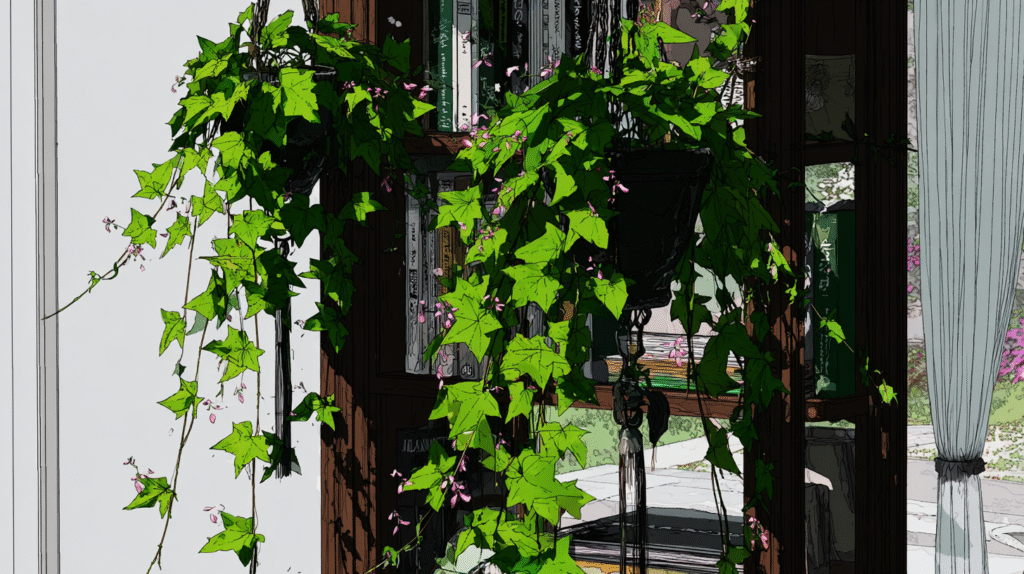My first ivy plant was supposed to be foolproof. “English ivy is perfect for beginners!” the garden center lady chirped while ringing up my $8.99 purchase. “Just water it and watch it grow!”
Six weeks later, I was googling “why is my ivy crispy” while staring at what looked like autumn happened exclusively to my plant. Brown leaves everywhere. Vines going bald. The “foolproof” plant had made a fool of me.
Turns out, indoor ivy has opinions. Strong ones. And if you don’t respect those opinions, it’ll throw the botanical equivalent of a temper tantrum. But here’s the thing — once I figured out what ivy actually wants (versus what everyone says it wants), it became one of my favorite houseplants. Now I have ivy trailing from my bookshelf, climbing up a moss pole, and cascading from hanging baskets. My apartment looks like a cottage core Pinterest board, and I’m not mad about it.

Why Everyone Gets Indoor Ivy Wrong
The problem with ivy is that people think of it as this indestructible outdoor vine that covers buildings. You know, the stuff that universities have to pressure wash off their historic architecture. So we bring it inside thinking it’ll be equally unstoppable.
Nope. Indoor ivy is a completely different beast. It’s like expecting a wolf to act like a golden retriever just because they’re both canines.
Indoor ivy wants specific things, and when it doesn’t get them, it doesn’t slowly decline like a polite houseplant. It stages a dramatic death scene that would make Shakespeare jealous. But give it what it wants? You’ll have more ivy than you know what to do with.
The Four Things Indoor Ivy Actually Needs
After killing three ivies (RIP Green Dreams, Ivy League, and Bob), I finally cracked the code:
1. Cool Temperatures:
This was my biggest revelation. Ivy HATES heat. My first ivy lived near a heating vent. No wonder it crisped up like bacon. Ivy wants temps between 50-70°F. My happiest ivy lives in my bedroom, which I keep at a chilly 65°F. My boyfriend complains, but the ivy is thriving, so…
2. Humidity That Actually Matters
Misting is useless. There, I said it. That five seconds of moisture does nothing for ivy. What works:
- Humidifier nearby (game changer)
- Bathroom placement if you have a window
- Pebble trays that actually stay filled with water
- Grouping with other plants
My ivy went from crispy to lush when I moved it to my bathroom. The shower humidity is like a daily spa treatment.
3. Bright Light (But Not What You Think):
“Tolerates low light” is technically true. My ivy in the dark corner is alive. But it’s also leggy, sparse, and honestly kind of ugly. The one near my north window? Thick, bushy, Instagram-worthy. Bright indirect light makes the difference between surviving ivy and thriving ivy.
4. Watering Like You Mean It:
Ivy likes consistently moist soil. Not wet, not dry, but that perfect in-between that drives new plant parents crazy. I check mine every 3-4 days. When the top inch is dry, I water. In winter, maybe every week. The key is consistency — ivy hates drought-flood cycles.
Varieties That Actually Work Indoors
Not all ivy is created equal. Some varieties are drama queens, others are chill. Here’s what I’ve learned:
English Ivy (Hedera helix):
The classic. Dozens of varieties. ‘Glacier’ with white edges is gorgeous and fairly easy. ‘Needlepoint’ has cute bird-foot shaped leaves.
Algerian Ivy:
Bigger leaves, grows faster, slightly less fussy about humidity. Good for beginners who want quick results.
Swedish Ivy:
Not actually ivy but everyone calls it that. WAY easier than true ivy. Start here if you’re nervous.
Skip the fancy variegated types until you’ve kept basic green ivy alive for six months. They need more light and throw bigger tantrums.
The Pest Problem Nobody Warns You About
Spider mites LOVE ivy. Love it. It’s like ivy sends out a bat signal for spider mites to come party. I’ve dealt with three infestations, and now I’m proactive:
- Check under leaves weekly
- Shower the plant monthly (literally, in the shower)
- Keep humidity up (spider mites hate moisture)
- Quarantine new plants always
First sign of webbing or stippled leaves? Shower immediately, spray with insecticidal soap, repeat weekly until they’re gone. Don’t wait. Spider mites multiply faster than gossip.
Propagation: Infinity Ivy
This is where ivy redeems itself. Propagation is stupid easy:
- Cut a 4-6 inch piece with a few leaves
- Remove bottom leaves
- Stick in water
- Wait 2 weeks for roots
- Plant when roots are 1-2 inches
Success rate: 90% easy. I’ve created an ivy army from one plant. Everyone I know has received ivy cuttings. It’s becoming a problem.

Training Your Ivy (Yes, Like a Pet)
Ivy wants to climb or trail. Your job is directing traffic:
For trailing:
Hang it high, let gravity work. Trim regularly to keep it full. I rotate mine weekly so it doesn’t go lopsided.
For climbing:
Moss pole, trellis, or even command hooks with string. Ivy has aerial roots that grip surfaces. Guide it initially, then it takes over.
For bushy growth:
Pinch tips regularly. Each pinch creates two new growth points. More pinching = fuller plant.
I have one ivy trained around my window frame. Took a year, but now it looks like I live in a fairy tale.
Seasonal Care That Makes the Difference
Spring/Summer: Growth explosion. Water more, feed monthly with diluted fertilizer, trim and train constantly.
Fall/Winter: Chill time. Growth slows, water less, no fertilizer, don’t panic if nothing happens.
Understanding this stopped me from overwatering in winter (ivy death sentence #2).
Common Problems Solved
Crispy brown leaves: Too hot, too dry, or both. Move somewhere cooler, increase humidity.
Leaves dropping: Could be too dry, too wet, or spider mites. Investigate like a detective.
Leggy growth: Not enough light. Move closer to window, pinch tips for bushiness.
Variegation fading: Definitely not enough light. Variegated types are divas about brightness.
Whole vine dying: Cut it off, check for root rot. Ivy bounces back from aggressive pruning.
Why I Keep Growing Ivy Despite the Drama
Yeah, it’s fussier than advertised. Yes, spider mites are a constant threat. Sure, it demands specific conditions. But when ivy is happy? Nothing else gives you that cottage garden vibe indoors. Those trailing vines soften hard edges, add life to boring corners, and make any space feel cozier.
My reading nook is framed by ivy trailing from shelves. My bathroom feels like a spa with ivy cascading from the cabinet. My kitchen window sports an ivy valance that gets compliments from everyone.
Plus, once you dial in the conditions, it’s actually pretty low maintenance. Water when dry, trim when wild, check for bugs weekly. That’s it. For that minimal effort, I get living curtains of green that make my apartment feel like a storybook.
Your Indoor Ivy Survival Guide
The truth about indoor ivy:
- Keep it cool (under 70°F)
- Humidity is non-negotiable
- Bright indirect light for best growth
- Consistent moisture (not soggy)
- Watch for spider mites always
- Pinch and train for shape
That first crispy ivy taught me that “easy” plants aren’t always easy. But they’re worth figuring out. Now I’m the ivy friend who forces cuttings on everyone and gives unsolicited humidity advice.
Just remember: outdoor ivy and indoor ivy are different creatures. Respect the indoor version’s needs, and you’ll have more ivy than you know what to do with. Ignore them, and you’ll be sweeping up brown leaves while wondering where you went wrong. Trust me — I’ve done both. 🌿







